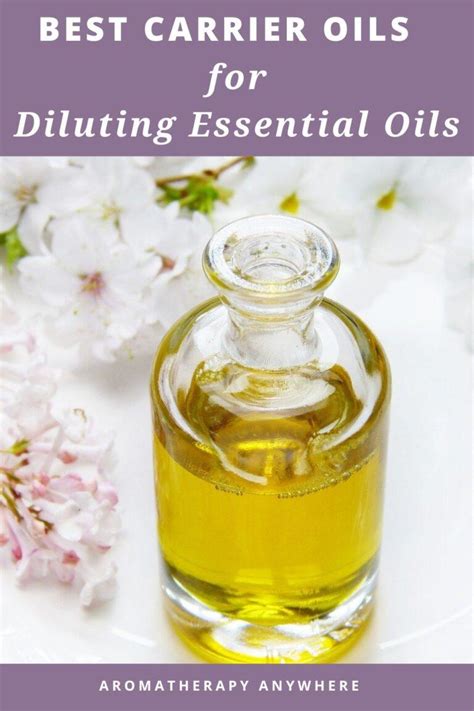Introduction:

Essential oils have gained immense popularity in recent years due to their therapeutic and aromatic benefits. However, these highly concentrated substances must be diluted with carrier oils to ensure safe and effective use. Carrier oils play a crucial role in delivering essential oils to the skin and enhancing their overall benefits.
Understanding Carrier Oils
Carrier oils are vegetable oils extracted from plant sources. They are typically odorless, colorless, and have a high affinity for essential oils. When combined with essential oils, carrier oils create a blend that can be safely applied to the skin without causing irritation or sensitization.
Types of Carrier Oils
There are numerous carrier oils available, each with its unique properties and absorption rates.
| Carrier Oil | Absorption Rate |
|---|---|
| Jojoba oil | Medium |
| Sweet almond oil | Medium |
| Coconut oil | Slow |
| Grapeseed oil | Fast |
| Olive oil | Medium to slow |
Choosing the Right Carrier Oil
The choice of carrier oil depends on the desired absorption rate and the specific needs of the individual.
- Fast-absorbing carrier oils, such as grapeseed oil, are suitable for quick and targeted applications.
- Medium-absorbing carrier oils, like jojoba oil and sweet almond oil, provide a balanced absorption rate.
- Slow-absorbing carrier oils, such as coconut oil and olive oil, are ideal for longer-lasting applications on dry skin.
Benefits of Using Carrier Oils with Essential Oils
Incorporating carrier oils with essential oils offers numerous benefits:
- Dilution: Diluting essential oils with carrier oils reduces their concentration and makes them safe for topical use.
- Increased absorption: Carrier oils enhance the penetration and absorption of essential oils into the skin.
- Skin nourishment: Carrier oils themselves possess moisturizing and nourishing properties, contributing to skin health.
- Enhanced efficacy: When combined with essential oils, carrier oils can potentiate their therapeutic effects.
- Massage: Carrier oils facilitate smooth and gentle massage by reducing friction between the skin and the therapist’s hands.
Tips for Using Carrier Oils
- Choose high-quality carrier oils: Pharmaceutical-grade or cold-pressed carrier oils ensure purity and effectiveness.
- Follow recommended dilution ratios: Refer to the essential oil label or consult with an aromatherapist for appropriate dilution ratios.
- Patch test before use: Apply a small amount of the blend to a small area of skin to test for any potential reactions.
- Use glass containers: Essential oils and carrier oils should be stored in amber or dark glass bottles to protect against light exposure.
- Avoid using expired oils: Essential oils and carrier oils have limited shelf lives. Discard expired products to ensure efficacy.
Applications of Essential Oil Blends with Carrier Oils
Carrier oil blends with essential oils find application in various aspects of health and well-being:
- Skin care: Essential oils blended with carrier oils can be used for moisturizing, soothing, and rejuvenating the skin.
- Aromatherapy: Diffusing essential oils in carrier oils helps create a relaxing or stimulating atmosphere.
- Massage: Massage blends combine essential oils with carrier oils to improve circulation, reduce muscle tension, and promote relaxation.
- Pain relief: Blends of essential oils with carrier oils can be applied topically to alleviate pain from headaches, sprains, and other conditions.
- Sleep: Essential oils in conjunction with carrier oils can promote relaxation and improve sleep quality when applied to the soles of the feet or diffused in the bedroom.
Creative Applications of Carrier Oils and Essential Oils
Beyond traditional uses, carrier oils and essential oils can be explored for innovative applications:
- Bath bombs: Create hydrating and fragrant bath bombs by combining essential oils with carrier oils, Epsom salts, and baking soda.
- Scented candles: Infuse candles with essential oils blended in carrier oils to create a relaxing or energizing ambiance.
- Facial steams: Add a few drops of essential oils to a bowl of hot water with a carrier oil to create a soothing facial steam.
- DIY cosmetics: Enhance the properties of homemade lotions, balms, and soaps by incorporating essential oils diluted in carrier oils.
- Pet care: Dilute essential oils in carrier oils and apply them topically to soothe pet skin irritations or diffuse them in a pet-friendly environment.
Industry Trends and Research
The global carrier oils market is projected to grow exponentially in the coming years due to the increasing demand for natural and organic skin care products.
- According to the Cosmetics Business website, the global carrier oils market was valued at USD 2.8 billion in 2021 and is expected to reach USD 5.2 billion by 2029.
- A study published in the Journal of Cosmetic Dermatology found that carrier oils enhance the penetration and efficacy of essential oils in topical applications.
Conclusion:
Carrier oils are indispensable components for the safe and effective use of essential oils in aromatherapy and natural health practices. By understanding the types and benefits of carrier oils, individuals can choose the most suitable options to dilute essential oils and reap their numerous therapeutic benefits. With a little creativity and experimentation, carrier oils and essential oils can be combined to develop innovative applications that enhance well-being and bring joy to daily life.
